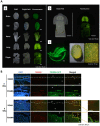Three-Dimensional Digital Light-Processing Bioprinting Using Silk Fibroin-Based Bio-Ink: Recent Advancements in Biomedical Applications
- PMID: 36551978
- PMCID: PMC9775525
- DOI: 10.3390/biomedicines10123224
Three-Dimensional Digital Light-Processing Bioprinting Using Silk Fibroin-Based Bio-Ink: Recent Advancements in Biomedical Applications
Abstract
Three-dimensional (3D) bioprinting has been developed as a viable method for fabricating functional tissues and organs by precisely spatially arranging biomaterials, cells, and biochemical components in a layer-by-layer fashion. Among the various bioprinting strategies, digital light-processing (DLP) printing has gained enormous attention due to its applications in tissue engineering and biomedical fields. It allows for high spatial resolution and the rapid printing of complex structures. Although bio-ink is a critical aspect of 3D bioprinting, only a few bio-inks have been used for DLP bioprinting in contrast to the number of bio-inks employed for other bioprinters. Recently, silk fibroin (SF), as a natural bio-ink material used for DLP 3D bioprinting, has gained extensive attention with respect to biomedical applications due to its biocompatibility and mechanical properties. This review introduces DLP-based 3D bioprinting, its related technology, and the fabrication process of silk fibroin-based bio-ink. Then, we summarize the applications of DLP 3D bioprinting based on SF-based bio-ink in the tissue engineering and biomedical fields. We also discuss the current limitations and future perspectives of DLP 3D bioprinting using SF-based bio-ink.
Keywords: bio-ink; biomedical application; digital light processing; silk fibroin; three-dimensional bioprinting.
Conflict of interest statement
The authors declare no conflict of interest.
Figures









Similar articles
-
Silk Fibroin Bioinks for Digital Light Processing (DLP) 3D Bioprinting.Adv Exp Med Biol. 2020;1249:53-66. doi: 10.1007/978-981-15-3258-0_4. Adv Exp Med Biol. 2020. PMID: 32602090 Review.
-
Precisely printable and biocompatible silk fibroin bioink for digital light processing 3D printing.Nat Commun. 2018 Apr 24;9(1):1620. doi: 10.1038/s41467-018-03759-y. Nat Commun. 2018. PMID: 29693652 Free PMC article.
-
Digital Light Processing Based Bioprinting with Composable Gradients.Adv Mater. 2022 Jan;34(1):e2107038. doi: 10.1002/adma.202107038. Epub 2021 Oct 23. Adv Mater. 2022. PMID: 34609032 Free PMC article.
-
Light-based 3D bioprinting of bone tissue scaffolds with tunable mechanical properties and architecture from photocurable silk fibroin.Int J Biol Macromol. 2022 Mar 31;202:644-656. doi: 10.1016/j.ijbiomac.2022.01.081. Epub 2022 Jan 20. Int J Biol Macromol. 2022. PMID: 35066028
-
Recent Developments in Bio-Ink Formulations Using Marine-Derived Biomaterials for Three-Dimensional (3D) Bioprinting.Mar Drugs. 2024 Mar 16;22(3):134. doi: 10.3390/md22030134. Mar Drugs. 2024. PMID: 38535475 Free PMC article. Review.
Cited by
-
The Upper Limb Orthosis in the Rehabilitation of Stroke Patients: The Role of 3D Printing.Bioengineering (Basel). 2023 Oct 27;10(11):1256. doi: 10.3390/bioengineering10111256. Bioengineering (Basel). 2023. PMID: 38002380 Free PMC article. Review.
-
Advances of 3D bioprinting technology for periodontal tissue regeneration.iScience. 2025 Apr 25;28(6):112532. doi: 10.1016/j.isci.2025.112532. eCollection 2025 Jun 20. iScience. 2025. PMID: 40487440 Free PMC article. Review.
-
Tendon stem cells seeded on dynamic chondroitin sulfate and chitosan hydrogel scaffold with BMP2 enhance tendon-to-bone healing.Heliyon. 2024 Jan 28;10(4):e25206. doi: 10.1016/j.heliyon.2024.e25206. eCollection 2024 Feb 29. Heliyon. 2024. PMID: 38370180 Free PMC article.
-
Review of Spider Silk Applications in Biomedical and Tissue Engineering.Biomimetics (Basel). 2024 Mar 11;9(3):169. doi: 10.3390/biomimetics9030169. Biomimetics (Basel). 2024. PMID: 38534854 Free PMC article. Review.
-
Advances in Preparation and Properties of Regenerated Silk Fibroin.Int J Mol Sci. 2023 Aug 24;24(17):13153. doi: 10.3390/ijms241713153. Int J Mol Sci. 2023. PMID: 37685960 Free PMC article. Review.
References
Publication types
Grants and funding
- NRF-2020R1A2C3010040/National Research Foundation of Korea (NRF) grant funded by the Korea government (MSIP)
- HI21C1847/Korea Health Technology R&D Project through the Korea Health Industry Development Institute (KHIDI)
- NRF-2022R1I1A1A01071825/Basic Science Research Program through the National Research Foundation of Korea (NRF)
- None/Hallym University research fund
LinkOut - more resources
Full Text Sources

